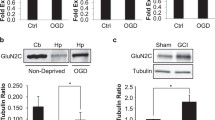Abstract
Immediately following ischemia, glutamate accumulates in the extracellular space and results in extensive stimulation of its receptors including N-methyl-D-aspartate (NMDA) and α-amino-3-hydroxy-5-methyl-4-isoxazole-propionic acid (AMPA) receptors. A large amount of Ca2+ influx directly through the receptor-gated ion channels which leads to Ca2+ overload and triggers several downstream lethal reactions. As a result, cell dies via apoptosis or necrosis, or both. Death-associated protein kinase 1 (DAPK1) physically and functionally interacts with the NMDA receptor GluN2B subunit at extra-synaptic sites and this interaction acts as a central mediator for stroke damage. The goal of this study is to explore an effective strategy in the treatment of stroke with a molecular genetic manipulation to interrupt DAPK1-GluN2B interaction. We generated a mutant strain of mice with the conditional deletion of GluN2B C-terminal tail consisting of amino acids 886–1269 in the forebrain excitatory neurons (the GluN2B mutant mice) and tested the protective effects of this mutation in stroke damages. GluN2B mutation effectively disrupted the DAPK1-GluN2B interaction and inhibited extra-synaptic NMDA receptor currents without affecting synaptic NMDA receptor channel activity in the central neurons. GluN2B mutation protected against stroke damages both in vitro and in vivo and hence improved behavioral performance. Disruption of the DAPK1-GluN2B interaction is therapeutically effective against stroke damages.







Similar content being viewed by others
References
Benveniste H, Drejer J, Schousboe A, Diemer NH (1984) Elevation of the extracellular concentrations of glutamate and aspartate in rat hippocampus during transient cerebral ischemia monitored by intracerebral microdialysis. J Neurochem 43:1369–1374. doi:10.1111/j.1471-4159.1984.tb05396.x
Krajewski S, Krajewska M, Ellerby LM, Welsh K, Xie Z, Deveraux QL et al (1999) Release of caspase-9 from mitochondria during neuronal apoptosis and cerebral ischemia. Proc Natl Acad Sci U S A 96:5752–5757. doi:10.1073/pnas.96.10.5752
Fiskum G, Murphy AN, Beal MF (1999) Mitochondria in neurodegeneration: acute ischemia and chronic neurodegenerative diseases. J Cereb Blood Flow Metab 19:351–369. doi:10.1097/00004647-199904000-00001
Kinouchi H, Epstein CJ, Mizui T, Carlson E, Chen SF, Chan PH (1991) Attenuation of focal cerebral ischemic injury in transgenic mice overexpressing CuZn superoxide dismutase. Proc Natl Acad Sci U S A 88:11158–11162
Aarts M, Liu Y, Liu L, Besshoh S, Arundine M, Gurd JW et al (2002) Treatment of ischemic brain damage by perturbing nmda receptor- psd-95 protein interactions. Science 298:846–850. doi:10.1126/science.1072873
Uehara T, Nakamura T, Yao D, Shi ZQ, Gu Z, Ma Y et al (2006) S-nitrosylated protein-disulphide isomerase links protein misfolding to neurodegeneration. Nature 441:513–517. doi:10.1038/nature04782
Pei L, Shang Y, Jin H, Wang S, Wei N, Yan H et al (2014) Dapk1-p53 interaction converges necrotic and apoptotic pathways of ischemic neuronal death. J Neurosci Off J Soc Neuroscie 34:6546–6556. doi:10.1523/JNEUROSCI.5119-13.2014
Madden DR (2002) The structure and function of glutamate receptor ion channels. Nat Rev Neurosci 3:91–101. doi:10.1038/nrn725
Chatterton JE, Awobuluyi M, Premkumar LS, Takahashi H, Talantova M, Shin Y et al (2002) Excitatory glycine receptors containing the NR3 family of NMDA receptor subunits. Nature 415:793–798. doi:10.1038/nature715
Sprengel R, Suchanek B, Amico C, Brusa R, Burnashev N, Rozov A, et al (1999) Importance of the intracellular domain of NR2 subunits for NMDA receptor function in vivo. Cell. 1998;92:279–289. doi:http://dx.doi.org/10.1016/S0092-8674(00)80921-6
Hardingham GE, Fukunaga Y, Bading H (2002) Extrasynaptic nmdars oppose synaptic nmdars by triggering creb shut-off and cell death pathways. Nat Neurosci 5:405–414. doi:10.1038/nn835
Martel MA, Ryan TJ, Bell KF, Fowler JH, McMahon A, Al-Mubarak B et al (2012) The subtype of gluN2 C-terminal domain determines the response to excitotoxic insults. Neuron 74:543–556. doi:10.1016/j.neuron.2012.03.021
Tu W, Xu X, Peng L, Zhong X, Zhang W, Soundarapandian MM et al (2010) DAPK1 interaction with NMDA receptor NR2B subunits mediates brain damage in stroke. Cell 140:222–234. doi:10.1016/j.cell.2009.12.055
Wang W, Jiang B, Sun H, Ru X, Sun D, Wang L et al (2017) Prevalence, incidence, and mortality of stroke in China: results from a nationwide population-based survey of 480 687 adults. Circulation 21;135:759–771. doi:10.1161/CIRCULATIONAHA.116.025250
Pei L, Wang S, Jin H, Bi L, Wei N, Yan H et al (2015) A novel mechanism of spine damages in stroke via DAPK1 and tau. Cereb Cortex 25(11):4559–4571 https://doi.org/10.1093/cercor/bhv096
Acknowledgements
This work was supported by the National Natural Science Foundation of China (Grants: 81130079, 91232302, 91132725 to YL and 81571078 to LP). We sincerely thank Ms. Na Wei (HUST) for behavioral analyses, Dr. Hui-Juan Jin (HUST) for mice breeding and genotypes, Shan Wang (HUST) for Western blot analysis, and Dr. Hengye Man (Boston University) for the comments on the manuscript.
Author information
Authors and Affiliations
Corresponding authors
Ethics declarations
Care and experiments with animals were in accordance with institutional guidelines and the Animal Care and Use Committee (Huazhong University of Science and Technology, Wuhan, China).
Conflict of Interest
The authors declare that they have no conflict of interest.
Rights and permissions
About this article
Cite this article
Tang, N., Wu, J., Zhu, H. et al. Genetic Mutation of GluN2B Protects Brain Cells Against Stroke Damages. Mol Neurobiol 55, 2979–2990 (2018). https://doi.org/10.1007/s12035-017-0562-y
Received:
Accepted:
Published:
Issue Date:
DOI: https://doi.org/10.1007/s12035-017-0562-y




